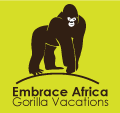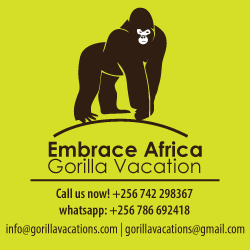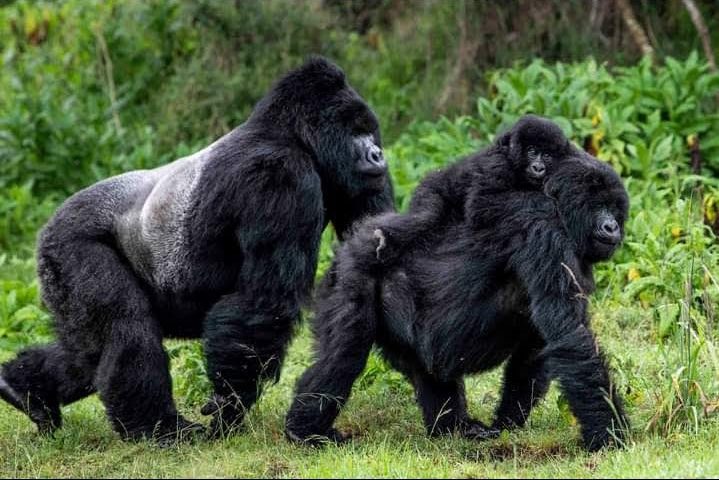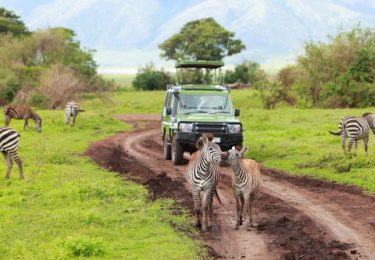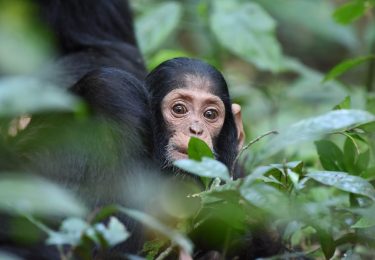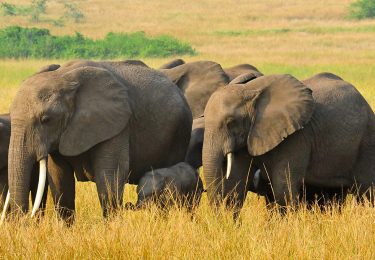- Home
- About Us
- Uganda safaris
- Long Safaris
- Short Safaris
- Day Short Safaris
- 1 Day Entebbe Botanical gardens weekend birding excursion
- I Day Entebbe City Tour
- 1 Day Jinja, Mabira, Ssezibwa Tour
- 1 Day Jinja Source of the Nile tour
- Lake Victoria Sunset Cruises
- 1 Day Kampala City Tour
- 1 Day Mabamba Shoebill Stork And Birding Tour
- 1 Day Makanaga Shoebill And Birding Trip
- 1 Day Ngamba Island Boat And Chimpanzee Excursion
- Other Tours
- Gorilla Safaris
- Uganda Gorilla safaris
- 4 Days Mgahinga Bwindi gorilla and golden monkey trekking safari
- 3 Days Mgahinga Gorilla trekking safari
- 5 Days Mgahinga Gorillas, Golden Monkey And Lake Bunyonyi Tour
- 5 Days Gorillas And Wildlife, L.Mburo, Bwindi and L. Bunyonyi
- 8 Days Wildlife, Gorillas, Golden Monkeys Trip
- 8 Days Gorillas Chimpanzee and wildlife Trekking Tour
- 9 Days Kidepo Valley National park and Bwindi Gorilla Safari. Wildlife and gorillas
- 11 Days Gorilla And Chimpanzee Tracking and wildlife Safari
- Rwanda Gorilla Safaris
- Uganda Gorilla safaris
- National Parks
- Kidepo Safaris
- Queen Elizabath Safaris
- Lake Mburo Safaris
- Mgahinga
- Mgahinga Gorilla National Park
- 3 Days Mgahinga Gorilla trekking safari
- 4 Days Mgahinga Bwindi gorilla and golden monkey trekking safari
- 5 Days Rwand-Uganda Gorilla, Golden Monkey trekking trip
- 5 Days Mgahinga Gorillas, Golden Monkey And Lake Bunyonyi Tour
- 8 Days Wildlife, Gorillas, Golden Monkeys Trip
- Our Blog
- Other Safaris
- Home
- About Us
- Uganda safaris
- Long Safaris
- Short Safaris
- Day Short Safaris
- 1 Day Entebbe Botanical gardens weekend birding excursion
- I Day Entebbe City Tour
- 1 Day Jinja, Mabira, Ssezibwa Tour
- 1 Day Jinja Source of the Nile tour
- Lake Victoria Sunset Cruises
- 1 Day Kampala City Tour
- 1 Day Mabamba Shoebill Stork And Birding Tour
- 1 Day Makanaga Shoebill And Birding Trip
- 1 Day Ngamba Island Boat And Chimpanzee Excursion
- Other Tours
- Gorilla Safaris
- Uganda Gorilla safaris
- 4 Days Mgahinga Bwindi gorilla and golden monkey trekking safari
- 3 Days Mgahinga Gorilla trekking safari
- 5 Days Mgahinga Gorillas, Golden Monkey And Lake Bunyonyi Tour
- 5 Days Gorillas And Wildlife, L.Mburo, Bwindi and L. Bunyonyi
- 8 Days Wildlife, Gorillas, Golden Monkeys Trip
- 8 Days Gorillas Chimpanzee and wildlife Trekking Tour
- 9 Days Kidepo Valley National park and Bwindi Gorilla Safari. Wildlife and gorillas
- 11 Days Gorilla And Chimpanzee Tracking and wildlife Safari
- Rwanda Gorilla Safaris
- Uganda Gorilla safaris
- National Parks
- Kidepo Safaris
- Queen Elizabath Safaris
- Lake Mburo Safaris
- Mgahinga
- Mgahinga Gorilla National Park
- 3 Days Mgahinga Gorilla trekking safari
- 4 Days Mgahinga Bwindi gorilla and golden monkey trekking safari
- 5 Days Rwand-Uganda Gorilla, Golden Monkey trekking trip
- 5 Days Mgahinga Gorillas, Golden Monkey And Lake Bunyonyi Tour
- 8 Days Wildlife, Gorillas, Golden Monkeys Trip
- Our Blog
- Other Safaris
MGAHINGA GORILLA NATIONAL PARK

KIBALE FOREST NATIONAL PARK
January 23, 2024
MOUNT ELGON NATIONAL PARK
January 23, 2024Mgahinga Gorilla National Park also referred to as “where gold meets silver” is the smallest amongst the 10 national parks in Uganda, situated in the southwestern part of the country in Kisoro district, close to Bwindi Impenetrable National Park. The British administration declared it a game sanctuary in 1930 but later upgraded it to a national park in 1991 mainly to protect the mountain gorillas and the endangered golden monkeys that were in frequent conflicts with humans living within and around the park. Its covering an area of 33.9 square kilometers but adjoins Volcanoes National Park in Rwanda and the southern sector of Virunga National Park in the Democratic Republic of Congo. Conjointly, these three mountains form the transboundary known as the “Virunga Conservation Area” (VCA) which protects half of the World’s Mountain Gorillas (780 gorillas) and the rest are in Bwindi Impenetrable National Park.
The Park is located in the Virunga mountains and comprises of three (3) inactive volcanoes; Mount Sabinyo, Mount Muhavura and Mount Gahinga. Due to these mountains, the park lies on high altitude of between 2,000 to 4,000 meters. Additionally, Mgahinga Gorilla National Park is part of the Nile River watershed area. Its vegetation is covered with bamboo forests, Ruwenzori-Virunga montane moorlands, savanna grassland, tropical forests, Albertine Rift montane forests, marshes, bogs, afro-montane forests and an alpine zone at higher altitudes. When it comes to climate, the area experiences the wet season in the months of February to May and September to December; the average monthly rainfall varies from 250 mm in October to 10 mm in July. The mountains and thick forests bring in frequent rains and cool breeze.
The national park is a vital water catchment area; several streams flow from swamps and crater lakes on the mountain summit to the rivers such as river Nyabirerema, river Ntebeko and river kabiranvuma which supply water to the indigenous tribes living next to the park.
Historically, the name Mgahinga was derived from a Kinyarwanda word “Gahinga” that simply means ‘pile of volcanic lava stone heaps that are carried on cultivation’. Furthermore, Muhavura means ‘guide’ well as Sabinyo means ‘the old man’s teeth’. Mgahinga Gorilla National Park is for sure a stunning place and really offers scenic views because of the three volcanoes as mentioned above and hiking to the top of them will give you unforgettable experience. Mount Muhavura has got a crater lake, Mount Gahinga has got a swamp on top of it and lastly Mount Sabinyo will give you the best experience ever; climbing to its summit makes you set a foot into three countries; Rwanda, Democratic Republic of Congo and Uganda at the same time.
Besides the primates, the park is a home to over 76 mammal species though difficult to be spotted due to the thick vegetation. Some of the mammals you will encounter are; forest buffalo, forest elephant, bush pig, blue monkey, black and white colobus, golden monkey, mountain gorillas, leopard, black-fronted duiker, rodents, bats, golden cat, bushbuck, giant forest hog, South African porcupines and small predators. Mgahinga Gorilla National Park has also got over 180 bird species including; 14 endemic Albertine rift notably the Kivu ground thrush, Cinnamon bracken warbler, Rwenzori turaco, Archer’s robin chat, Black headed waxbill, White starred robin, Rwenzori batis, Olive pigeon, Western green tinker bird and Cape robin. Other bird species here are; scarlet-tufted, Brown woodland warbler, striped breasted tit, Malachite kingfisher, Greater double collard sunbird, Paradise flycatcher, White-necked raven, Fire finch stonechat, Dusky turtle dove, Grey capped warbler, Black kite, Crowned hornbill and more.
Mgahinga Gorilla National Park is a home to over 100 mountain gorillas with one habituated gorilla family known as “Nyakagezi”. After the habituation, the gorilla family was led by a silverback called “Bugingo” who later was taken down by “Mark silverback”. Right after Mark took over the leadership, Bugingo stayed in the group and was given a tittle of “Mzee” meaning “Elderly”. As mentioned above, the group is led by Mark but with the assistance of his brother “Mafia” who is the assistant; the group is made up of 10 members including 5 silverbacks namely; Bugingo, Mark, Mafia, Rukundo and Ndugutse. It has also got 2 adult females; Nyiramwiza and Nshuti, and lastly 3 infants; Mutagamba, Fred and baby Nshuti.
The indigenous tribes that live on the edges of the park are; Batwa, Bakiga and Bafumbira who rely mainly on subsistence farming using terracing on the slopes of the mountains. There is human encroachment and pressure on the park land leading to deforestation in areas close to human settlements and this is due to lack of alternative ways of earning income. The population groups amongst the communities living outside the park is a threat in spite of the fact that the Uganda Wildlife Authority (UWA) has contained poaching. Well, the good news is that UWA has come up with community tourism programs that have created a very good relationship between the park authorities and the local people living outside the park.
WHAT TO DO IN MGAHINGA GORILLA NATIONAL PARK
Gorilla trekking
Gorilla trekking in Mgahinga gorilla national park starts early in the morning at 8:00 am with a briefing about the dos and don’ts at the Ntebeko park headquarters by the ranger. After the briefing, you will be grouped into groups of 8 people and each group with a ranger to led it to the habituated family. Physical fitness is a mandate while planning to do this activity therefore if any tourist is not physically fit, him/her is expected to communicate earlier so that they can allocate for you a gorilla family that is near. This activity takes 2 to 4 hours and upon finding the gorilla family, you will spend an hour with them in their natural habitat, learning about their lifestyles, behaviors, feeding, playing, habits, taking pictures and recording videos of them for memories to take back home. After the activity, you will return to the park headquarters where you will be awarded from a gorilla certificate as a sign of appreciation.
Golden monkey trekking
This interesting activity that makes the park famous because Mgahinga Gorilla National Park is the only destination for the endangered golden monkeys in the country. Golden monkey trekking starts at 8:00 am at the park headquarters for briefing about the do and don’ts to follow while the trekking by the ranger. After the briefing, your guide will lead you into the forest to locate the golden monkeys and his will take around 1 to 2 hours because these primates move from one place to another in search of food; bamboo and insects. As you carryout your trekking, follow left overs of bamboo leaves as they primates don’t leave any makings behind. Once the golden monkeys are found, you will be allowed to spend an hour with them in their habitat which will give you a chance to jump up in tree branches, feeding, play and you will also get a chance of taking photos for memories.
Bird watching
The Park is a good place for birding due to its different trails; the bamboo trail which starts from 2500meters above sea level and the gorge trail that lies between Sabinyo and Gahinga that takes 3 hours. The birds you will encounter include; Dusky turtle dove, Grey capped warbler, Black kite, Crowned hornbill, , Brown woodland warbler, striped breasted tit, Malachite kingfisher, Greater double collard sunbird, Paradise flycatcher, White-necked raven, Fire finch stonechat, Kivu ground thrush, Cinnamon bracken warbler, Rwenzori turaco, Archer’s robin chat, Black headed waxbill, White starred robin, Rwenzori batis, Olive pigeon, Western green tinker bird and Cape robin, to mention a few.
Nature walks
This activity is done around the edges of the mountains and it’s very interesting; tourists carry it out around the Rugezi swamp, bamboo forests and wild vegetation which gives them a wide chance of having beautiful scenic views of agricultural areas, forest birds and surrounding lakes like Lake Mutanda. You can also hike up to the Gisozi hill where you will experience great views of the several calderas, Bunagana and Kisoro town.
Batwa cultural experience
This park was formally a home to the Batwa people who lived almost all their lives in the forest with the Mountain gorillas before being evicted by the Uganda Wildlife Authority. Once you take the Batwa trail, your experience will begin with a prayer and also a chance to meet the Batwa people whom you will associate with and know more about their; ancient culture, ancient ways, games, storytelling, singing and dancing, hunting, honey harvesting, gathering skills, making fire by rubbing two dry sticks among others. While here, don’t miss to visit the Garamba cave which acted as a food storage and hiding place for the Batwa people.
Volcano climbing
Mgahinga Gorilla National Park has got three Virunga volcanoes as mentioned above namely, Mount Muhabura which is the highest with 4,127 meters, Mount Sabinyo with 3,669 meters and lastly Mount Gahinga with 3,474 meters above sea level. Climbing each of these mountains offers a different experience; Mount Sabinyo provides birding and you will also get an opportunity to stand in three counties; Uganda, Rwanda and Democratic Republic of Congo at once, Mount Muhabura offers beneficial sceneries such as viewing Queen Elizabeth National Park, Rwenzori peaks and Lake Edward. Lastly Mount Gahinga will give you a chance to view a crater filled swamp and giant lobelia.
Best time to visit
This gorilla park can be visited through out the year but the best or the most favorable time is during the dry season in the months of June to September and December to February because during this period, road are easily accessed, nature walks and gorilla trekking trails will be dry and passable which makes gorilla trekking and hiking easy.
How to get there?
Mgahinga Gorilla National Park is approximately 510 kilometers away from Kampala the capital city of Uganda and you can get there by road or air.
By road: you can access the park through Kampala-Masaka-Mbarara-Kisoro -Mgahinga that’s is 9-10 hours’ drive.
By air: endeavor to make earlier bookings on flights that move from the Entebbe International Airport or from one of the airstrips in Kajjansi that will fly you to Kisoro air field. Air transport is less tiresome and saves more time.
